Research into Preparation and Performance of Fast-Hardening RPC Mixed with Straw
Abstract
:1. Introduction
2. Experimental
2.1. Raw Materials
2.2. Specimen Preparation
2.3. Measurement Method
2.3.1. Slump Flow and Setting Time Experiments
2.3.2. Mechanical Property Experiments
2.3.3. Compactness Experiments
3. Results and Discussion
3.1. Slump Flow and Setting Time Analysis
3.2. Mechanical Performance Analysis
3.3. Flexural Toughness Analysis
3.4. Microanalysis
4. Conclusions
Author Contributions
Funding
Institutional Review Board Statement
Informed Consent Statement
Data Availability Statement
Conflicts of Interest
References
- Chang, H.; Jin, Z.; Wang, P.; Wang, J.; Liu, J. Comprehensive resistance of fair-faced concrete suffering from sulfate attack under marine environments. Constr. Build. Mater. 2021, 277, 122312. [Google Scholar]
- Yang, C.; Okumus, P. Seismically Resilient Hybrid Precast Concrete Piers with Ultrahigh-Performance Concrete. J. Bridge Eng. 2021, 26, 001713. [Google Scholar] [CrossRef]
- Li, Y.; Zhang, Q.; Wang, R.; Xiong, X.; Li, Y.; Wang, J. Experimental Investigation on the Dynamic Mechanical Properties and Microstructure Deterioration of Steel Fiber Reinforced Concrete Subjected to Freeze-Thaw Cycles. Buildings 2022, 12, 2170. [Google Scholar] [CrossRef]
- Zhang, P.; Wang, C.; Gao, Z.; Wang, F. A review on fracture properties of steel fiber reinforced concrete. J. Build. Eng. 2023, 67, 105975. [Google Scholar] [CrossRef]
- Luo, X. Mechanical properties of steel fiber reinforced concrete material in construction of road bridge deck. Bridge Struct. 2021, 16, 169–176. [Google Scholar] [CrossRef]
- Gunasekaran, M.; Rashid, S.; Mugahed, A.; Vatin, N.; Fediuk, R. Drop Weight Impact Test on Prepacked Aggregate Fibrous Concrete—An Experimental Study. Materials 2022, 15, 3096. [Google Scholar]
- Sifan, M.; Nagaratnam, B.; Thamboo, J.; Poologanathan, K.; Corradi, M. Development and prospectives of lightweight high strength concrete using lightweight aggregates. Constr. Build. Mater. 2023, 362, 129628. [Google Scholar] [CrossRef]
- Zhao, C.; Wang, Z.; Zhu, Z.; Guo, Q.; Wu, X.; Zhao, R. Research on different types of fiber reinforced concrete in recent years: An overview. Constr. Build. Mater. 2023, 365, 130075. [Google Scholar] [CrossRef]
- Wu, H.; Qin, X.; Huang, X.; Kaewunruen, S. Engineering, Mechanical and Dynamic Properties of Basalt Fiber Reinforced Concrete. Materials 2023, 16, 623. [Google Scholar] [CrossRef]
- Tan, S.; Wang, C.; Zheng, Q.; Chen, F.; Huang, Y. Durability Performance of PVA Fiber Cement-Stabilized Macadam. Sustainability 2022, 14, 16953. [Google Scholar] [CrossRef]
- Du, Y.; Lu, S.; Xu, J.; Xia, W.; Wang, T.; Wang, Z. Experimental study of impact mechanical and microstructural properties of modified carbon fiber reinforced concrete. Sci. Rep. 2022, 12, 12928. [Google Scholar] [CrossRef]
- Xu, W.; Li, Y.; Li, H.; Wang, K.; Zhang, C.; Jiang, Y.; Qiang, S. Corrosion mechanism and damage characteristic of steel fiber concrete under the effect of stray current and salt solution. Constr. Build. Mater. 2022, 314, 125618. [Google Scholar] [CrossRef]
- Wang, H.; Jin, K.; Zhang, A.; Zhang, L.; Han, Y.; Liu, J.; Shi, F.; Feng, L. External erosion of sodium chloride on the degradation of self-sensing and mechanical properties of aligned stainless steel fiber reinforced reactive powder concrete. Constr. Build. Mater. 2021, 287, 123028. [Google Scholar] [CrossRef]
- Wang, H.; Zhang, A.; Zhang, L.; Liu, J.; Han, Y.; Shu, H.; Wang, J. Study on the influence of compound rust inhibitor on corrosion of steel bars in chloride concrete by electrical parameters. Constr. Build. Mater. 2020, 262, 120763. [Google Scholar] [CrossRef]
- Ziane, S.; Khelifa, M.; Mezhoud, S.; Beroual, A.; Medaoud, S. Experimental Study on the Durability Characteristics of Several Vegetable Fiber Reinforced Concretes Exposed to Sodium Sulfate. Civ. Environ. Eng. Rep. 2021, 31, 1–28. [Google Scholar] [CrossRef]
- Zhu, B.; Huang, X.; Xia, S.; Lin, L.; Cheng, Y.; He, L. Biomass-burning emissions could significantly enhance the atmospheric oxidizing capacity in continental air pollution. Environ. Pollut. 2021, 285, 117523. [Google Scholar] [CrossRef] [PubMed]
- Sun, N.; Gao, C.; Ding, Y.; Bi, Y.; Seglah, P.; Wang, Y. Five-Dimensional Straw Utilization Model and Its Impact on Carbon Emission Reduction in China. Sustainability 2022, 14, 16722. [Google Scholar] [CrossRef]
- Muhammad, U.; Majid, A. Effect of pre-treatment and content of wheat straw on energy absorption capability of concrete. Constr. Build. Mater. 2019, 224, 572–583. [Google Scholar]
- Liu, J.; Xie, X.; Li, L. Experimental study on mechanical properties and durability of grafted nano-SiO2 modified rice straw fiber reinforced concrete. Constr. Build. Mater. 2022, 347, 128575. [Google Scholar] [CrossRef]
- Hajj, O.; Douzane, O.; Freitas, D.; Promis, G.; Laidoudi, B.; Bordet, F.; Langlet, T. Physical and Mechanical Properties of Rapeseed Straw Concrete. Materials 2022, 15, 8611. [Google Scholar] [CrossRef] [PubMed]
- Ashour, T.; Morsy, M.; Korjenic, A.; Fischer, H.; Khalil, M.; Sesto, E.; Orabi, M.; Yehia, I. Engineering Parameters of Rice Straw Concrete with Granulated Blast Furnace Slag. Energies 2021, 14, 343. [Google Scholar] [CrossRef]
- Wu, X. Experimental study on strength evolution of C40 concrete under different curing conditions. Build. Constr. 2021, 43, 1664–1666. [Google Scholar]
- Cao, X.; Quan, Y.; Ren, Y.; Fu, F.; Jin, Q.; He, D.; Zheng, Y. Experiment study on reactive powder concrete beams using spirals reinforcement under torsion. Eng. Struct. 2023, 290, 116361. [Google Scholar] [CrossRef]
- Ge, W.; Zhang, Z.; Ashour, A.; Li, W.; Jiang, H.; Hu, Y.; Shuai, H.; Sun, C.; Li, S.; Liu, Y.; et al. Hydration characteristics, hydration products and microstructure of reactive powder concrete. J. Build. Eng. 2023, 69, 106306. [Google Scholar] [CrossRef]
- Liang, Z.; Peng, X.; Wang, H. The Influence of Aspect Ratio of Steel Fibers on the Conductive and Mechanical Properties of Compound Cement Reactive Powder Concrete. Coatings 2023, 13, 331. [Google Scholar] [CrossRef]
- Luo, W.; Wang, H.; Li, X.; Wang, X.; Wu, Z.; Zhang, Y.; Lian, X.; Li, X. Mechanical Properties of Reactive Powder Concrete with Coal Gangue as Sand Replacement. Materials 2022, 15, 1807. [Google Scholar] [CrossRef] [PubMed]
- Abdraimov, I.; Kopzhassarov, B.; Kolesnikova, I.; Akhmetov, D.; Madiyarova, I.; Utepov, Y. Frost-Resistant Rapid Hardening Concretes. Materials 2023, 16, 3191. [Google Scholar] [CrossRef]
- Zhou, H.; Qi, X.; Ma, C.; Fang, Z.; Lou, J.; Chen, H.; Guo, X. Effect and mechanism of composite early-strength agents on sulfoaluminate cement-based UHPC. Case Stud. Constr. Mater. 2023, 18, e01768. [Google Scholar] [CrossRef]
- Lin, J.; Liu, J.; Tang, T. Effect of composite early strength agent on the properties of high volume fly ash cement. Min. Res. Dev. 2021, 41, 47–51. [Google Scholar]
- Tang, B.; Zhang, T.; Hou, W. Research on maintenance technology of cement concrete for super early strength road. Road Traffic Technol. 2020, 16, 25–27+34. [Google Scholar]
- Jian, L.; Xiao, S.; Qiong, Z. Recycling of water quenched slag and silica sand tailing for the synthesis of an eco-friendly permeable material. Constr. Build. Mater. 2022, 357, 129310. [Google Scholar]
- Dudek, D.; Kadela, M.; Małek, M. Effect Steel Fibre Content on the Load-Carrying Capacity of Fibre-Reinforced Concrete Expansion Anchor. Materials 2021, 14, 7757. [Google Scholar] [CrossRef] [PubMed]
- Saha, S.; Saha, P.; Talluri, N. Effects of quality of water on the setting times and compressive strength of concrete. Mater. Today Proc. 2022, 60, 378–383. [Google Scholar] [CrossRef]
- Cao, Q.; Al, Q. Signal Stability and the Height-Correction Method for Ground-Penetrating Radar In Situ Asphalt Concrete Density Prediction. Transp. Res. Rec. 2021, 2675, 835–847. [Google Scholar] [CrossRef]
- Li, Y. Analysis of influencing factors of concrete compactness. Jiangxi Build. Mater. 2021, 9, 24–25+27. [Google Scholar]
- Tay, C.; Mazlan, N.; Wayayok, A.; Basri, M.; Mustafa, M.; Abdullah, A. Nanocellulose reinforced zeolite based geopolymer concrete: Density analysis through response surface methodology. Mater. Today Proc. 2022, 66, 2873–2882. [Google Scholar] [CrossRef]
- Wang, H.; Shi, F.; Shen, J.; Zhang, A.; Zhang, L.; Huang, H.; Liu, J.; Jin, K.; Feng, L.; Tang, Z. Research on the self-sensing and mechanical properties of aligned stainless steel fiber-reinforced reactive powder concrete. Cem. Concr. Compos. 2021, 119, 104001. [Google Scholar] [CrossRef]
- Su, Q.; Xu, J. Mechanical properties of concrete containing glass sand and rice husk ash. Constr. Build. Mater. 2023, 393, 132053. [Google Scholar] [CrossRef]
- Liang, L.; Wang, Q.; Shi, Q. Flexural toughness and its evaluation method of ultra-high performance concrete cured at room temperature. J. Build. Eng. 2023, 71, 106516. [Google Scholar] [CrossRef]
- Ding, Y.; Li, Y.; Zhao, X.; Dai, J.; Xu, H. Investigation into the Flexural Toughness and Methods of Evaluating Ductile Concrete. Appl. Sci. 2022, 12, 12313. [Google Scholar] [CrossRef]
- Dong, S.; Zhou, D.; Ashour, A.; Han, B.; Ou, J. Flexural toughness and calculation model of super-fine stainless wire reinforced reactive powder concrete. Cem. Concr. Compos. 2019, 104, 103367. [Google Scholar] [CrossRef]
- Wang, H.; Liu, J.; Gao, X.; Li, Y.; Cai, J.; Wang, J. Influence of salt freeze-thaw cycles on the damage and the following electrical and self-sensing performance of carbon nanofibers concrete. Mater. Res. Express 2019, 6, 025705. [Google Scholar] [CrossRef]
- Zhang, Y.; Cui, M.; Chen, G.; Han, W. Experimental study of the effects of graphene nanoplatelets on microstructure and compressive properties of concrete under chloride ion corrosion. Constr. Build. Mater. 2022, 360, 129564. [Google Scholar] [CrossRef]
- Sadawy, M.; Nooman, T. Influence of nano-blast furnace slag on microstructure, mechanical and corrosion characteristics of concrete. Mater. Chem. Phys. 2020, 251, 123092. [Google Scholar] [CrossRef]
- Loseva, E.; Potapov, A.; Osokin, A. Ultrasonic testing of concrete hardening in pile foundations. J. Phys. Conf. Ser. 2021, 1728, 012011. [Google Scholar] [CrossRef]
- Mansoori, E.; Morshedian, J.; Reza, R. Elaboration of X-ray shielding of highly barite-loaded polyester concrete: Structure, mechanical properties, and MCNP simulation. Constr. Build. Mater. 2023, 370, 130650. [Google Scholar] [CrossRef]
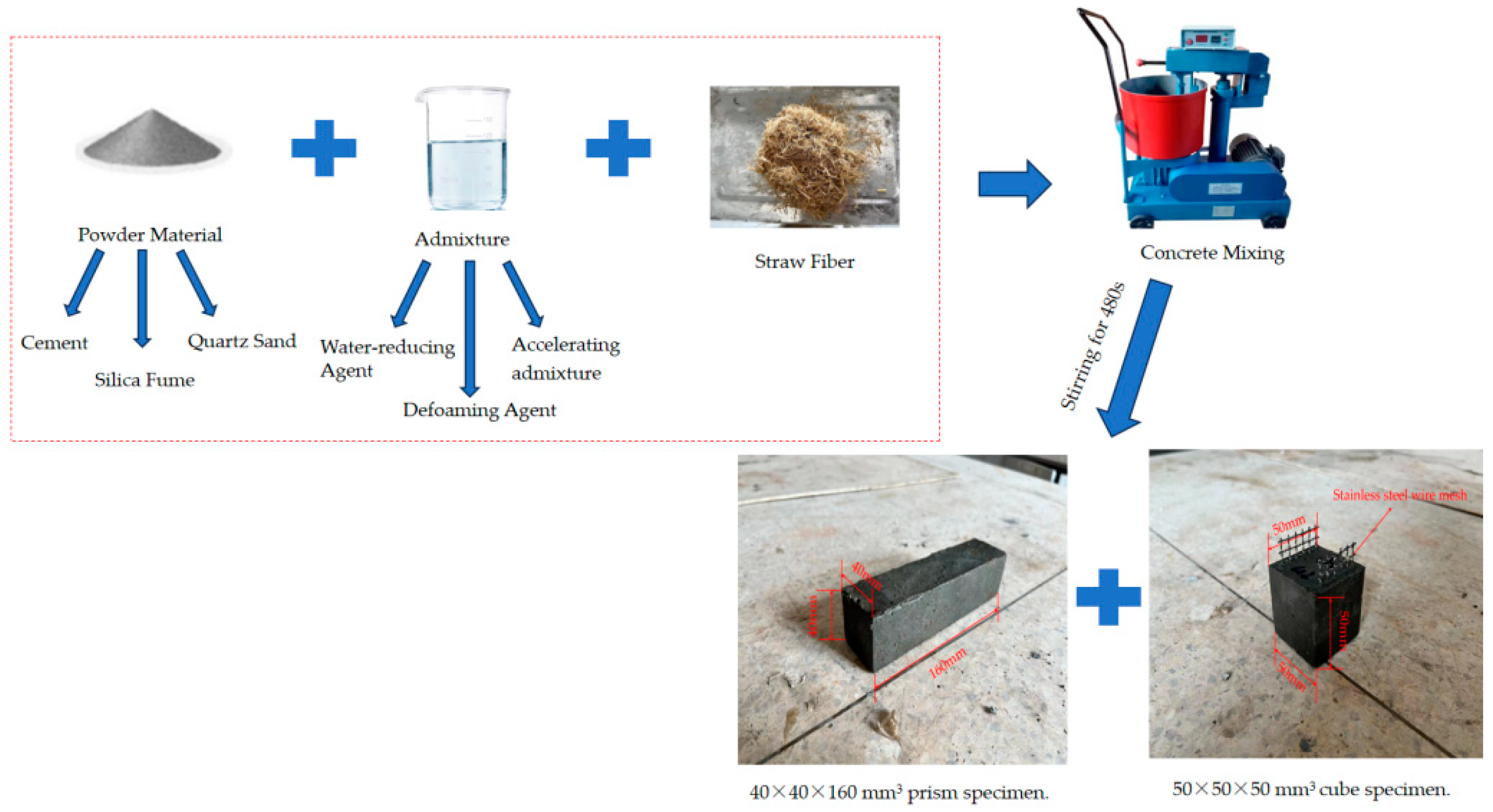
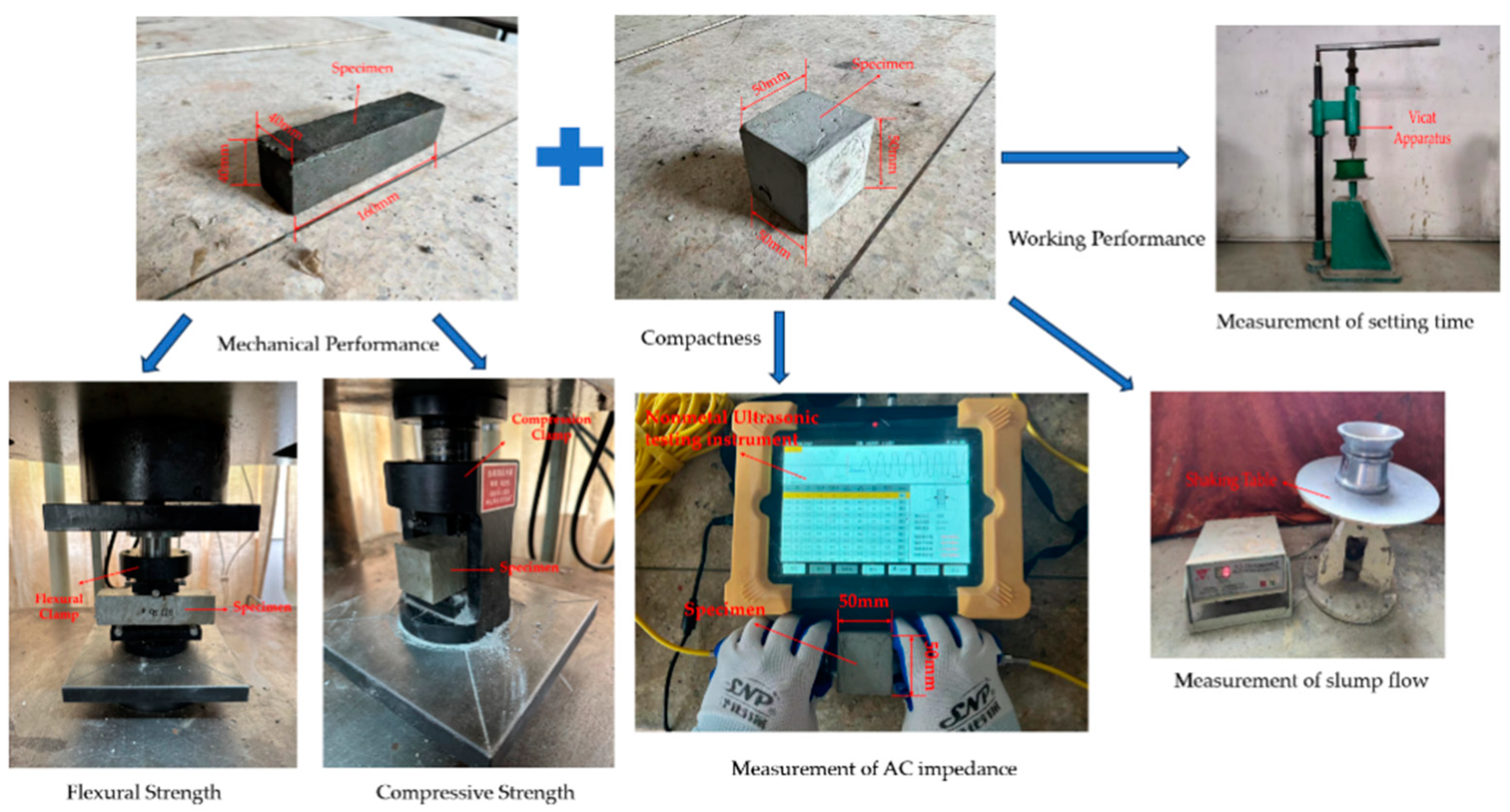

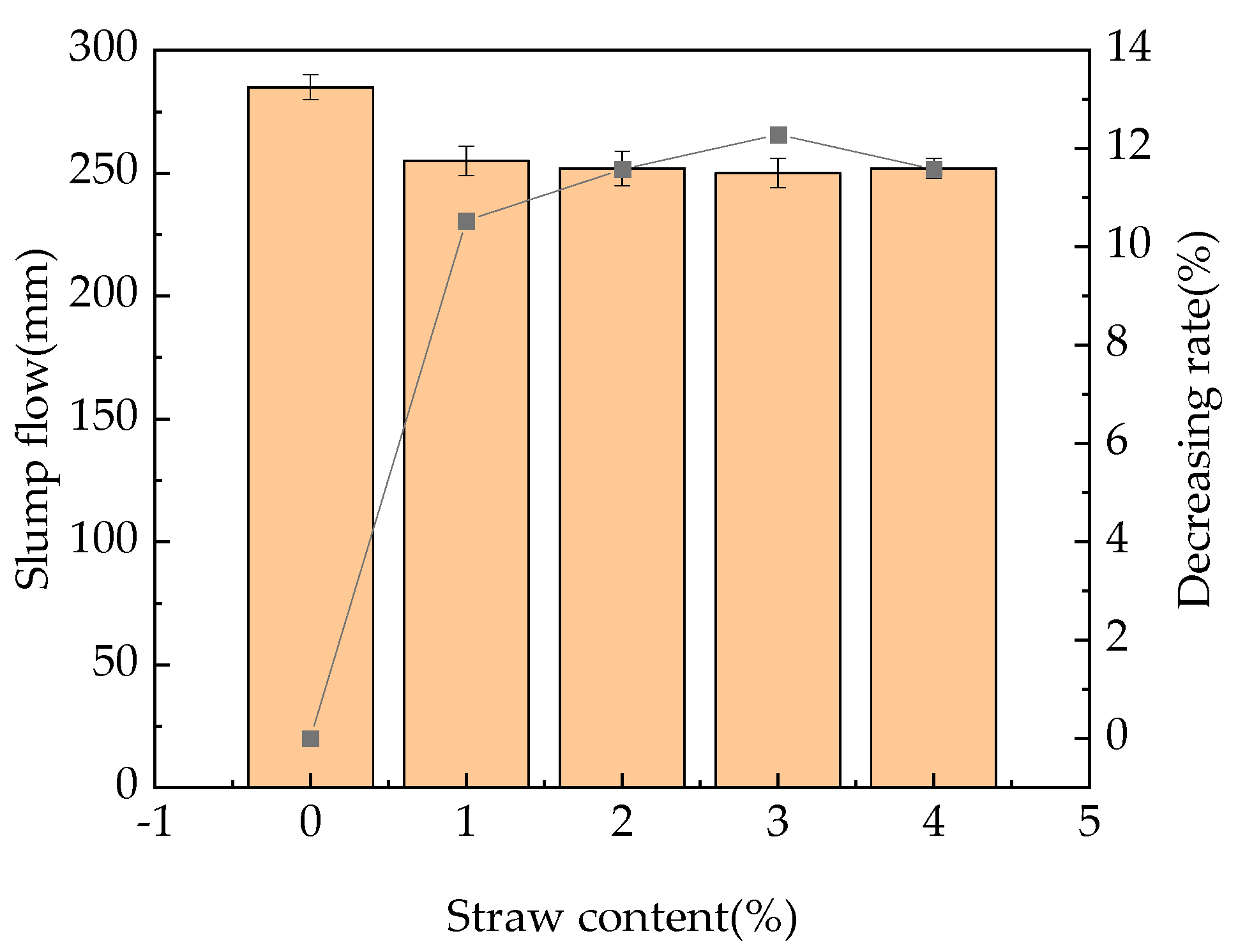
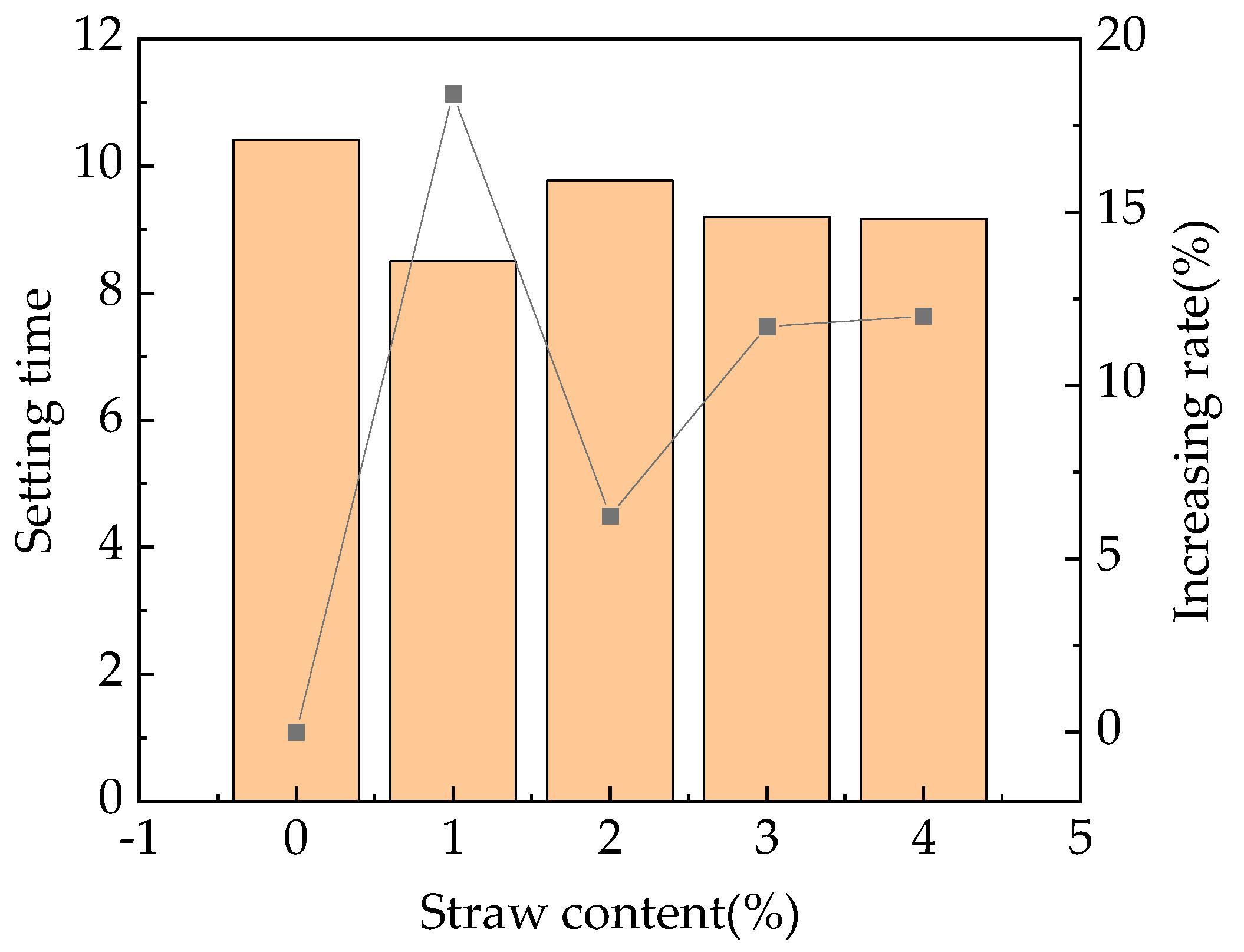

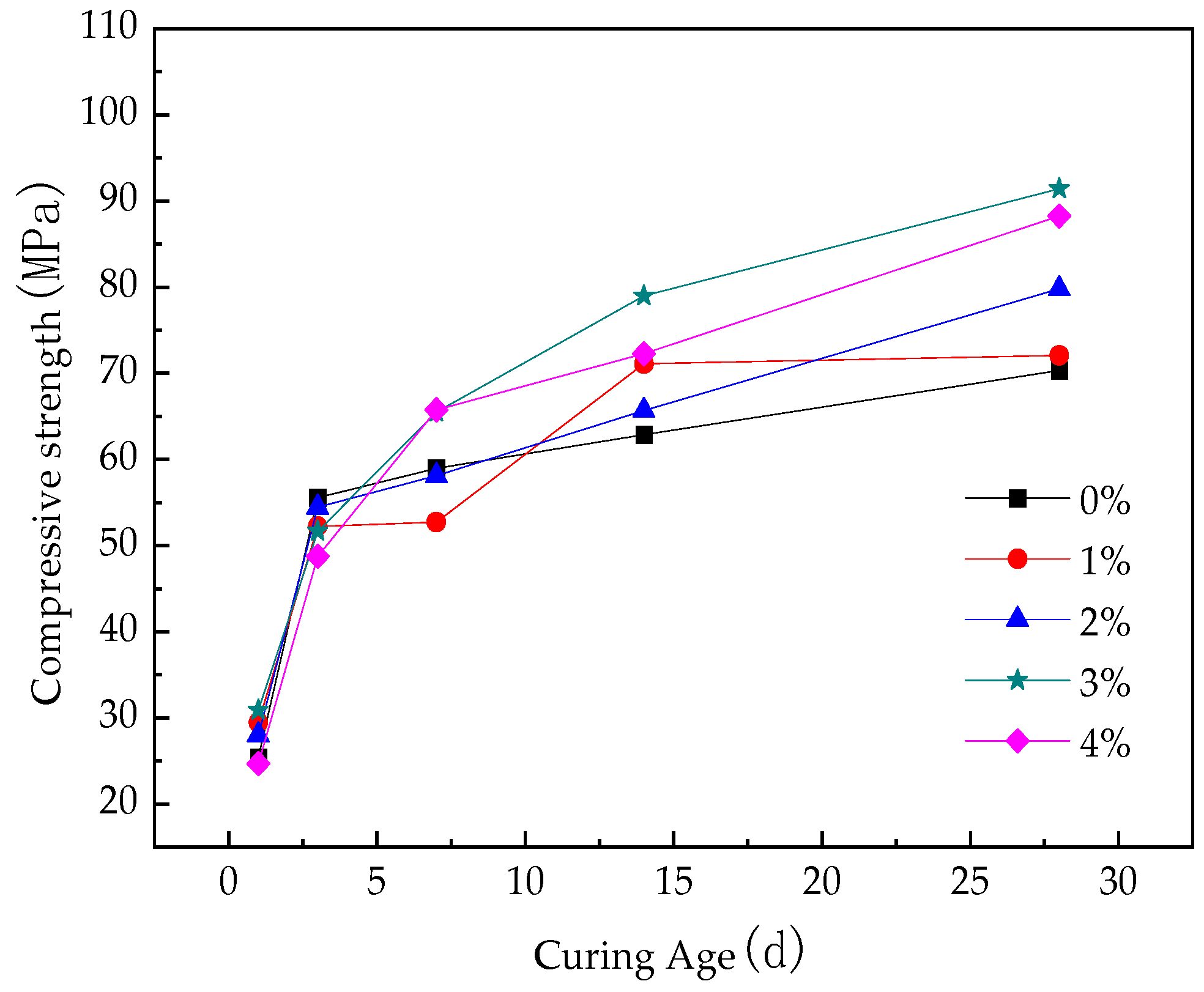

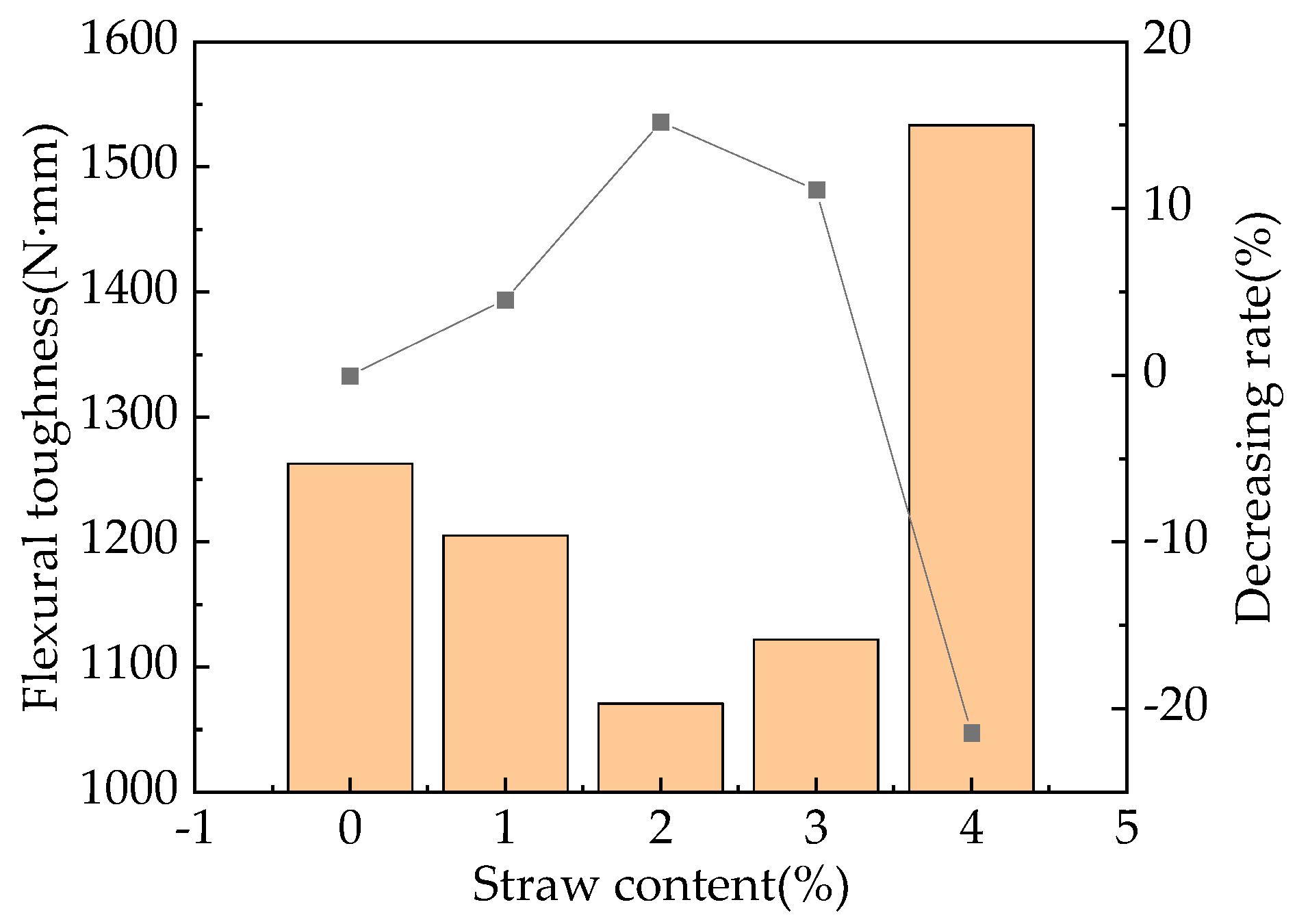
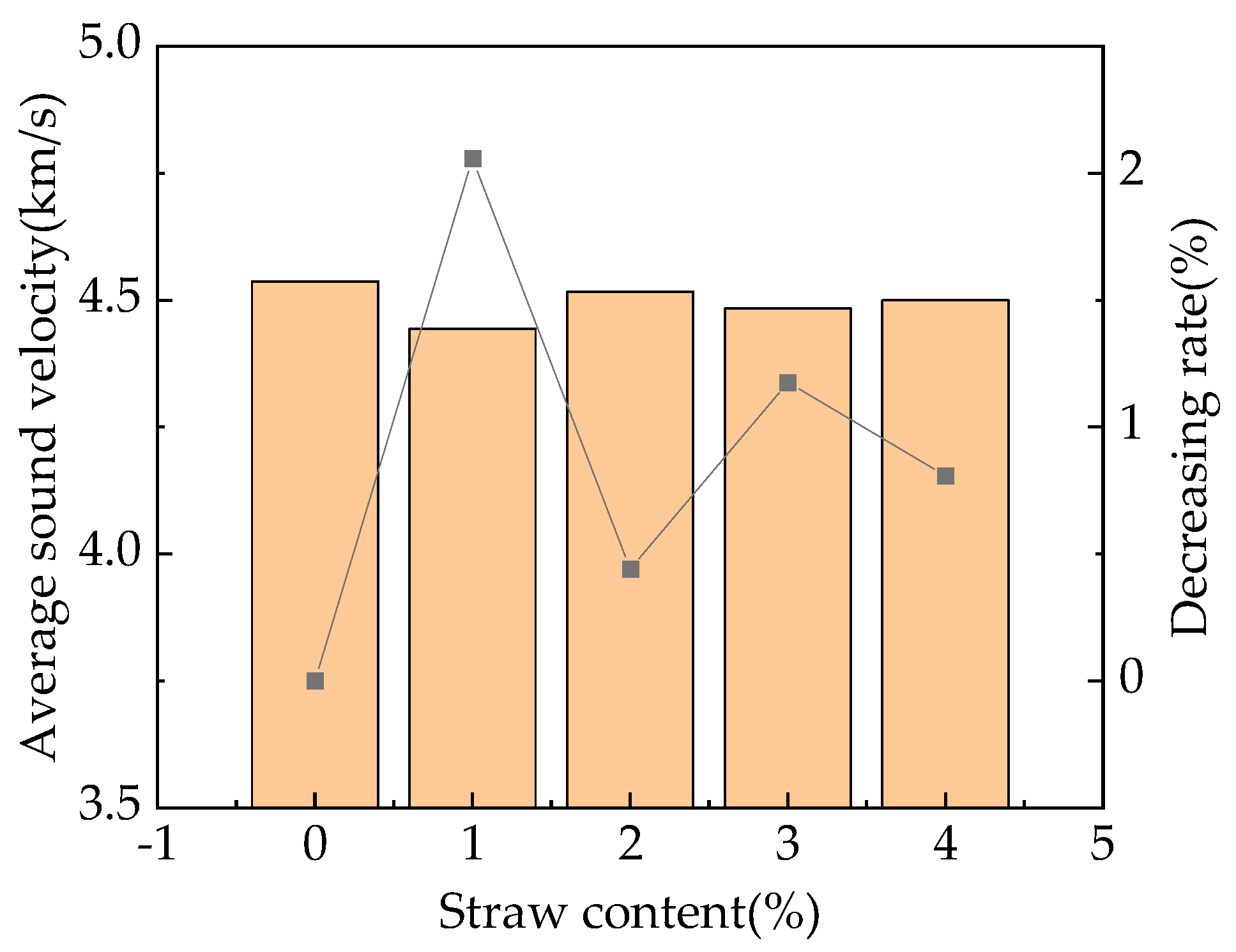

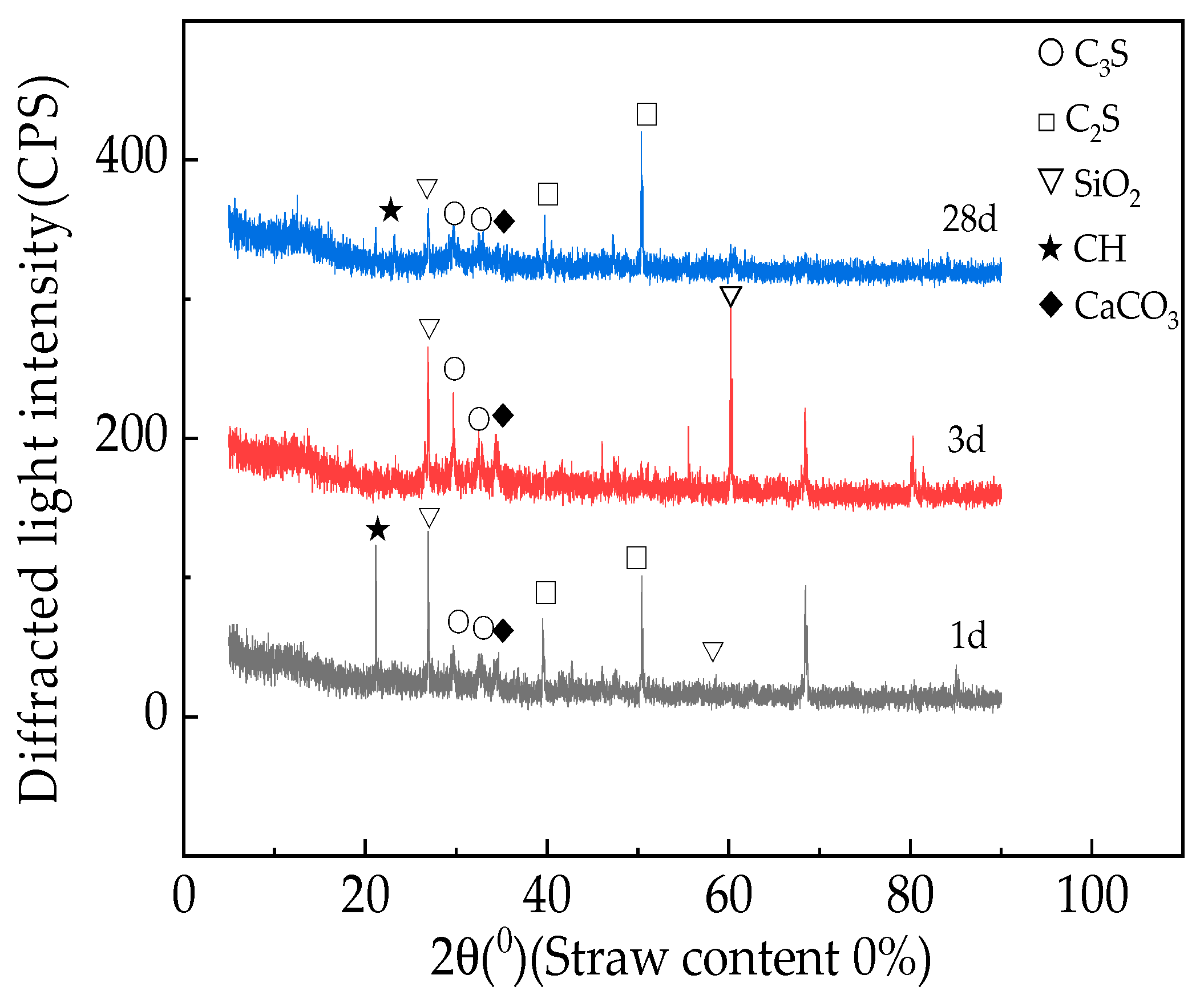
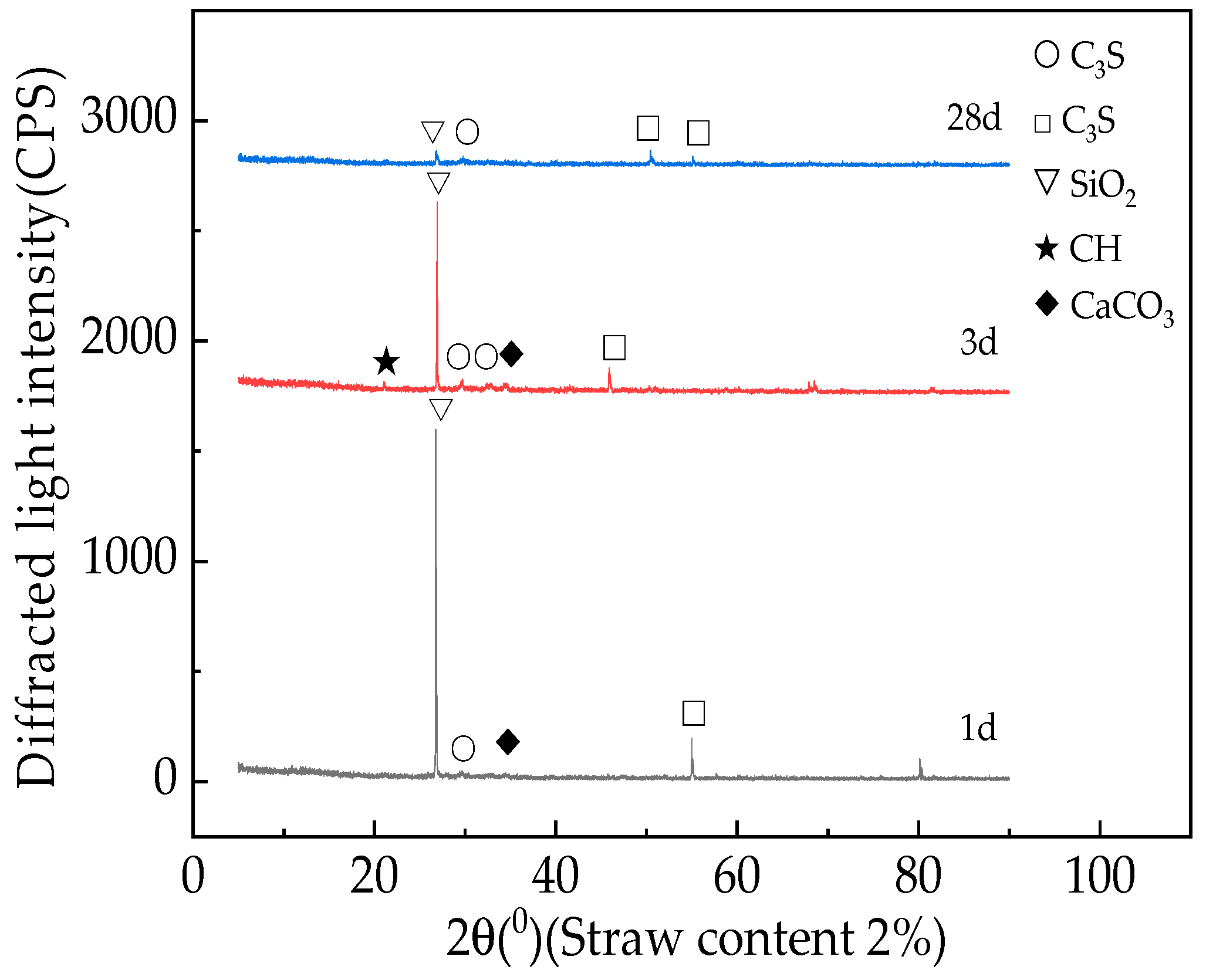

| Experimental Material | Characteristic |
|---|---|
| Cement | Specific surface: ≤350 m2/kg |
| Silica fume | Specific surface: 15 m2/g; density: 2.2 g/cm3; SiO2 content: ≥98% |
| Aggregate | Particle size: 1–0.71 mm, 0.59–0.35 mm, 0.15–0.297 mm; ratio: 1:1.5:0.8; main composition: SiO2 99.66%, Fe2O3 0.02%; specific surface: 2.5–3 m2/g; density: 2.2–2.3 g/cm3 |
| Straw | Density: 35 kg/m3; breaking strength: 3.86 cN/dtex−1; length: 1–2 cm; bulk density: 0.2334 g/cm3 |
| Water-reducing agent | High-efficiency water-reducing agent (SP) of polycarboxylic acid with a water reduction rate of up to 40% (teal micro-emulsion solution) |
| Defoamer | A mixture of polyether surfactant and dry powder carrier (white to light gray powder) |
| Particle Size/um | 0.3 | 0.6 | 1 | 4 | 8 | 16 | 32 | 64 | 360 | |
|---|---|---|---|---|---|---|---|---|---|---|
| Category | ||||||||||
| Silicate cement | 0 | 0.33 | 2.66 | 15.01 | 28.77 | 46.64 | 72.73 | 93.59 | 100 | |
| Silica fume | 31.2 | 58.3 | 82.3 | 100 | 100 | 100 | 100 | 100 | 100 | |
| Category | Chemical Composition/% | ||||||||
|---|---|---|---|---|---|---|---|---|---|
| SiO2 | Al2O3 | Fe2O3 | MgO | CaO | SO3 | R2O | MnO | H2O | |
| Silicate cement | 20.89 | 5.44 | 3.96 | 62.24 | 1.71 | 2.65 | 0.48 | 0 | 0 |
| Silica fume | 90 | 0.8 | 0.6 | 0.8 | 0.4 | 0 | 7.4 | 0 | 0 |
| Group | Water | Cement | Silica Fume | Quartz Sand | Water Reducer | Early Strength Agent | Defoamer | Straw |
|---|---|---|---|---|---|---|---|---|
| 1 | 1.500 | 4.500 | 1.500 | 3.000 | 0.060 | 0.0318 | 0.006 | 0 |
| 2 | 1.500 | 4.500 | 1.500 | 3.000 | 0.060 | 0.0318 | 0.00 | 0.0021 |
| 3 | 1.500 | 4.500 | 1.500 | 3.000 | 0.060 | 0.0318 | 0.006 | 0.0042 |
| 4 | 1.500 | 4.500 | 1.500 | 3.000 | 0.060 | 0.0318 | 0.006 | 0.0062 |
| 5 | 1.500 | 4.500 | 1.500 | 3.000 | 0.060 | 0.0318 | 0.006 | 0.0084 |
Disclaimer/Publisher’s Note: The statements, opinions and data contained in all publications are solely those of the individual author(s) and contributor(s) and not of MDPI and/or the editor(s). MDPI and/or the editor(s) disclaim responsibility for any injury to people or property resulting from any ideas, methods, instructions or products referred to in the content. |
© 2023 by the authors. Licensee MDPI, Basel, Switzerland. This article is an open access article distributed under the terms and conditions of the Creative Commons Attribution (CC BY) license (https://creativecommons.org/licenses/by/4.0/).
Share and Cite
Gong, K.; Liang, Z.; Peng, X.; Wang, H. Research into Preparation and Performance of Fast-Hardening RPC Mixed with Straw. Materials 2023, 16, 5310. https://doi.org/10.3390/ma16155310
Gong K, Liang Z, Peng X, Wang H. Research into Preparation and Performance of Fast-Hardening RPC Mixed with Straw. Materials. 2023; 16(15):5310. https://doi.org/10.3390/ma16155310
Chicago/Turabian StyleGong, Kaiwei, Zhao Liang, Xi Peng, and Hui Wang. 2023. "Research into Preparation and Performance of Fast-Hardening RPC Mixed with Straw" Materials 16, no. 15: 5310. https://doi.org/10.3390/ma16155310





